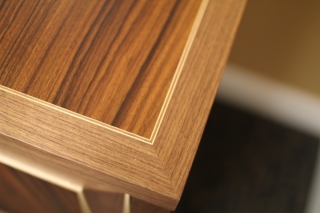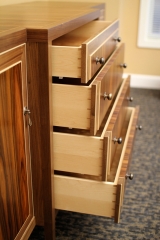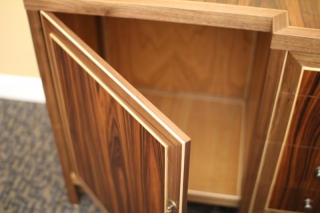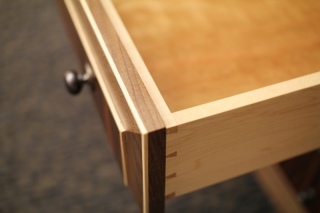
My client, Far West Capital, came to me asking me to build a credenza to match a conference table I had made for them earlier this year out of Rosewood and Walnut. My first thought was that the form should be simple and understated so it doesn’t take away from the conference table. Rosewood is a dominant wood that overpowers almost everything so it’s best to let the wood speak out and keep everything else simple. I also loved the way the white inlays helped outline and accent the dark timbers so I made that my sole design focus. What I ended up with is a design that’s very refined and exquisite not because of the forms or shapes but because of the details and the natural beauty of the wood.
The doors, drawers, and side panels are ‘raised’ panels with the rosewood panel sticking proud of the walnut frame. The raised panel is used often in traditional furniture and a solid piece of wood, beveled to fit inside a frame. With this piece, I raised the panel but kept the edges square and crisp. This creates a three dimensionality to the panels while keeping the the square and rectangular feel of the credenza. And with the use of a thin inlay, the final effect is more modern than traditional.
The interiors are made of Cherry. I chose a contrasting wood because I find it pleasant to see a light interior whenever a person opens up a dark cabinet. Traditionally, this was done because most houses had poor lighting. When the interior is lighter, it makes it easier for people to find what they’re looking for. I’ve kept the inlays going even on the inside panels of the cabinet even though it’s not visible unless you open the doors. I believe every area needs just as much attention as the rest of the piece.
The drawers are made of hard maple and they are joined with hand cut dovetails. Hand cut dovetails are becoming a rarity. It takes time to cut dovetails by hand, all your tools need to be super sharp and well tuned up, and it takes a lot of practice to get the skill. Machine cut dovetails are great for mass production since they’re faster to cut and takes less skill, but I’m a firm believer that hand cut dovetails are far superior and worth the extra effort and time. When you cut dovetails by hand, you can make the pins as small as the thickness of your saw blade on your handsaw. The smallest pins you can have on machine cut dovetails is limited to how small the router bit is (1/4″). Also, there’s much more freedom in the layout of the dovetails when you cut them by hand. You’re not limited to what the router jig is capable of, and the setup time for getting the dovetails exactly the way you want on the jig offsets the extra time it takes to hand cut dovetails. So at the end of the day, machine cut dovetails look too uniform and if I’m being perfectly honest, just plain boring. Even dovetails deserve the attention of proportions- not just whatever’s easiest.



